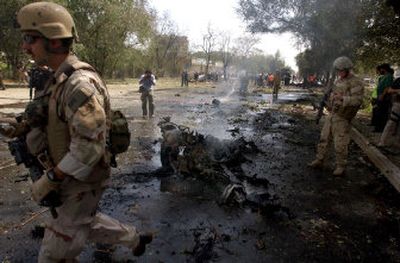Suicide bombing kills 17 in Kabul

KABUL, Afghanistan – In the most brazen attack yet on Kabul’s heavily guarded center, a car bomber rammed into an American Humvee outside the U.S. Embassy on Friday, killing 16 other people, including two U.S. soldiers.
It was the Afghan capital’s deadliest suicide attack since the 2001 toppling of the Taliban.
A purported Taliban spokesman, Qari Yousaf Ahmadi, claimed responsibility for the attack, according to the privately run Pajhwok Afghan News Agency. Ahmadi’s exact ties to the Taliban leadership are unclear.
The morning blast spewed body parts and pieces of U.S. military uniforms across a major road and into trees that were set ablaze by the explosion – part of the worst spate of violence in Afghanistan since the collapse of the hard-line Islamic regime.
The attack shattered what had been a typically peaceful Muslim sabbath in the war-ravaged capital and revealed the lingering vulnerability of foreign troops, local forces and Afghan civilians to terrorist attacks almost five years after a pro-American government was installed. Attacks in central Kabul have been rare in comparison to areas on the edge of the city and in the country’s south.
Some 20,000 NATO soldiers and a similar number of U.S. forces are trying to crush the emboldened Taliban insurgency, mainly in southern Afghanistan. Taliban holdouts have been turning to Iraqi-style tactics – including increasing numbers of suicide bombings – to try derail the government of President Hamid Karzai.
The attack took place as many Afghans were commemorating the assassination of anti-Taliban commander Ahmad Shah Massood, who was killed in an al-Qaida suicide bombing two days before the Sept. 11, 2001, attacks in the United States.
Friday’s explosion went off at 10:20 a.m. just 150 feet from the landmark Massood Square, which leads to the main gate of the heavily fortified American Embassy compound.
The blast’s force tore a 6-foot-wide crater into the road and shattered every window in a five-story, Soviet-era apartment block facing the bomb scene, spraying shards of glass over children eating their breakfasts and women cleaning their cramped homes. Restaurants and businesses on the other side of the road also had windows and doors blown in.
The blast tore apart an American Humvee, blowing it onto what had been its roof and turning it into twisted, flaming hulk of metal. All that remained of the bomb-packed car was its front end, which was covered in flames some 60 feet away.
An Associated Press reporter saw the bodies of two American soldiers lying near their burning vehicle. U.S. troops stood guard around the bodies, one of which was slumped in the gutter, the other covered by a plastic sheet. The U.S. military initially said two other soldiers were also wounded, but later revised it down to one.
Sixteen people in all were killed and 29 wounded, said Ali Shah Paktiawal, criminal director of the Kabul police. The bomber also died.
Najibullah Faizi, 25, saw a blue Toyota Corolla driven by a young, heavyset man speed past another car on the inside lane before slamming into one of two U.S. Humvees in a convoy.
“I fell to the ground after the blast. American soldiers started shooting at another car nearby. There was smoke and flames everywhere,” Faizi said.